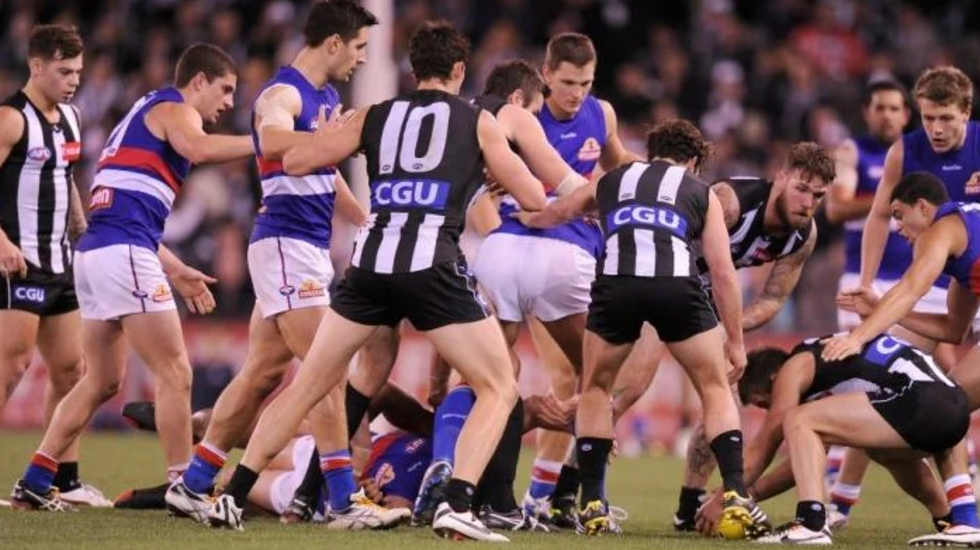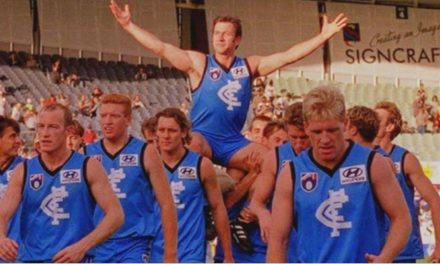To us oldies, a typical modern-day scrap. But are younger fans as unhappy with it as we are? Photo: FAIRFAX SYNDICATION
There’s two predominant narratives emerging in discussion of this AFL season. One is a natural consequence of circumstances. The other is becoming a bit of an annual talking point.
The extraordinary backdrop of a major health crisis has made hubs, floating fixtures and compacted schedules the buzzwords of the 2020 season, far more than most of the actual football. Which, given the flak the quality of some of that football has attracted, perhaps isn’t that surprising.
And that, the second major storyline, is of course, the state of the game. Even the instinctive ease with which that phrase now rolls off the tongue is an indicator of how familiar with this debate we’ve become, not only this year, but the several before that.
I’ve been as engaged in that discussion as anyone, and I make no apologies for it. Like a lot of football tragics of my vintage, or even 15-20 years younger, I’m deeply concerned that what I have considered the most attractive features of Australian football – long kicking, high marking, lots of run and plenty of scoring – are being swamped by a tidal wave of defensive thinking.
But what about those much younger? What about those still in their 20s, or teenagers or the young kids taking their first steps towards the game via Auskick?
Do the generations who will be driving football’s future actually think the game is in trouble? Or that this seemingly endless conversation is a lot of hot air, and the low-scoring, more defensive-oriented scraps we see predominate now are in fact how the game is and should be played?
Are the prized elements of football for them not those features cited above, but strong tackling, the ability to break free of congestion and find a teammate, or for defenders, the knack of zoning off an opponent at the right time and impacting a contest as a third man up? After all, they are the new basics with which they have grown up.
And does that mean their heroes are just as likely to be Gold Coast’s Hugh Greenwood (leading the AFL for tackles) or Nick Haynes (ditto for intercepts) as our take on who should be their heroes, like Dustin Martin, Nat Fyfe and Patrick Dangerfield?
I’m not sure we really know. I’m not sure we even know how to find out. But I’m pretty certain in all this discussion, that younger version of just where the game is at is a perspective we haven’t heard enough.
Not that it’s a deliberate snub. But the biggest soapboxes from which opinions on the game are broadcast are invariably the province of men generally at least well into their 30s if not considerably older.
Then there’s even older farts like me, at 55. We’re a generation for whom even things which seem to fall under the guise of “recent history” aren’t necessarily that recent at all.
For example, when I’m challenged about the dated nature of the football I remember most fondly, I often cite the greatest game I have seen, the 1994 preliminary final between Geelong and North Melbourne, as evidence I’m not talking about some crusty old memory off a black-and-white TV replay.
But that 1994 classic is now more than a quarter of a century ago. Anyone 25 or younger wasn’t even born when it was played. Indeed, without the aid of old footage, anyone younger than their mid-20s couldn’t possibly have experienced live and taken in properly a game of AFL football any earlier than 2000.
My memories of 1994, when I was 29, remain fresh enough. But if, back then, I’d asked myself to use a game 25 years previously as a reference point, the year in question would have been 1969. And that would have seemed ancient history indeed. As 2000 must now for younger fans.
Funnily enough, 2000 was a big year for attacking and free-scoring football, the points per team average in that season of 103 higher than it had been for seven years. But these days, that season looks like a complete mirage.
A decade later, average scores, having trended steadily down, had fallen by more than two goals per game per team. And by the end of last year, when the average points at just 80 was the lowest figure since 1967, it was just on four goals less than we were seeing in that first year of the new millennium.
The point being that the differences between football of 2020 and football of 2000 are arguably a far starker contrast than the differences between 2000 and, say, 1980. Certainly more wide-ranging than just on the scoreboard.
Consider this. Heading into the 21st century, teams were averaging 172 uncontested possessions per game. By the end of 2009, the average was 247, a rise of 43 per cent. Yep, that’s a lot of chipping around the half-back line ensuring the retention of possession.
Going into the 2000 season, teams were averaging 25 tackles per game. That average had doubled within seven years, and was up to almost 70 per game in 2016.
And the staggering rise of the interchange bench as a tactical weapon? Teams in 2003 still averaged fewer than 27 rotations per game. By 2013, that had spiralled to more than 133, forcing the introduction of the cap of first 120, then 90.
They have been massive changes. And if you’re under 20, completely consistent with the sort of football we watch today.
And who is to say that while us oldies have trouble comprehending how anyone could prefer the latter aesthetic, the kids who have known only this style of game don’t look at our supposed classics and shake their heads at the comparative lack of defensive pressure, ineffective tackling, and scorelines that more closely resemble basketball?
Me? Well, like most in my demographic, I’d much prefer we reverted to a game closer resembling that I grew up with. Perhaps, though, we need to consider more carefully the possibility that in “going back to the future”, we don’t saddle our successors in carrying football’s torch with a game they didn’t necessarily think needed changing at all.
This article first appeared at ESPN.










